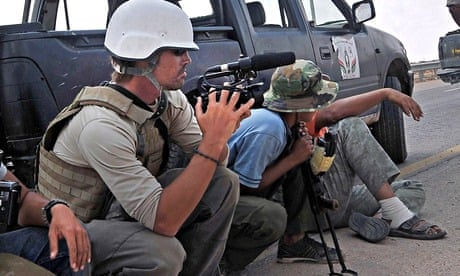For more than three years now, much of what the world has seen, read and learned about the Middle East has been produced by journalism's newest hands. They are not recruits, in the true sense of the word: few have the endorsement of established media outlets. Even fewer have been sent to the region with budgets, backing, or even basic training.
But from Tunisia to Syria and all stops in between, freelance reporters and photojournalists have reported history with a determination that old media could rarely match, even during the halcyon days when media organisations could afford to maintain correspondents and bureaux around the world.
Libya was a magnet for many freelancers when insurrection broke out in February 2011. Some had covered the tumult next door in Egypt, others were drawn to journalism, wanting to witness the end of Gaddafi's cult-like state.
As the battle for east Libya ebbed and flowed around the town of Ajdabiya, the freelancers at times outnumbered the anti-Gaddafi rebels on the frontline. Both groups – with a fair few staff reporters among them – would often surge forward together or scamper for safety when regime forces advanced. James Foley was among them.
Foley, an affable, former reporter for the US military newspaper Stars and Stripes, was typical of the new band. He arrived with a sense of purpose and opportunity and, at times, immunity to the dangers. There were plenty of potential buyers for his frontline images and no shortage of other like-minded young journalists willing to cut their teeth in war reporting.
In 2011 he was captured in Libya with two other freelancers. A friend travelling with them, the South African photographer Anton Hammerl, was killed. Around the same time, four New York Times journalists were outflanked by Gaddafi's troops, captured and taken to Tripoli. Foley was released after 44 days, and returned to reporting soon after.
For media organisations, ever tighter budgets and an abundance of eager freelancers meant that Libya was a buyer's market. Many freelance reporters worked with no insurance, no expenses, or even airfares to get them home again.
But Libya soon proved as potent and unpredictable as any other war. The good guy/bad guy narrative that appeared clear-cut at the start drifted steadily to uncertainty. Difficult, important, decisions needed to be made about who to trust and when to cut and run.
For many freelancers, safety in numbers offered the best strategy. Foley formed strong bonds with many colleagues he met along the way, some of whom he would work with, or be imprisoned alongside, in Syria.
After the fall of Tripoli and Gaddafi's death two months later, Libya rapidly became yesterday's news. By then, the new war in Syria was dominating. It soon became the most dangerous conflict to cover anywhere in the world. And many of those who had started reporting in north Africa were soon going to the sectarian killing fields of Aleppo, Idlib, Homs and Hama.
But the fact that the Syrian war was far more important did not mean any change in the way coverage was funded. Media outlets which wanted gripping tales and images were willingly taking work from Syria's frontlines. Foley was again front and centre, along with Manu Brabo, who had been captured with him in Libya and would go on to win a Pulitzer prize as a contract Associated Press photographer for his work in Syria.
All the while, they and other freelancers were using nothing more than their wits to survive in an ever more hostile environment. From the summer of 2012 to mid-2013 the risks taken by many reporters – including staffers with institutional backing – increasingly overshadowed the rewards. By then, working in northern Syria had become close to impossible because of the kidnap threat. Every trip over the border involved a real risk of not making it back.
Foley's luck ran out in November 2012. He was seized near the Syrian town of Binnish, along with another photographer with whom he had entered the country. Both were on the last day of a two-week trip through dangerous areas that they knew well.
Foley was initially captured by a local warlord who later joined the group Islamic State, bringing his valuable booty with him.
In the year that followed at least 11 more journalists were seized in Syria, including many staff reporters. Yet, still the demands for freelance work came, with few outlets prepared to insure any non-staffer working inside the country.
Stripped down, pared-back journalism has created opportunities for those who dare, but it has also allowed outlets to hide behind flaky bottom lines as a means of abdicating responsibility. Radio stations, television networks and print outlets continue to outsource their coverage to reporters who often work without basic protection.
The price of that dereliction has been paid in the dungeons of north Syria. The meltdown of the Middle East is one of the most important stories of our time, every bit as significant globally as the end of the cold war. Too many outlets have covered it through exploitation.
